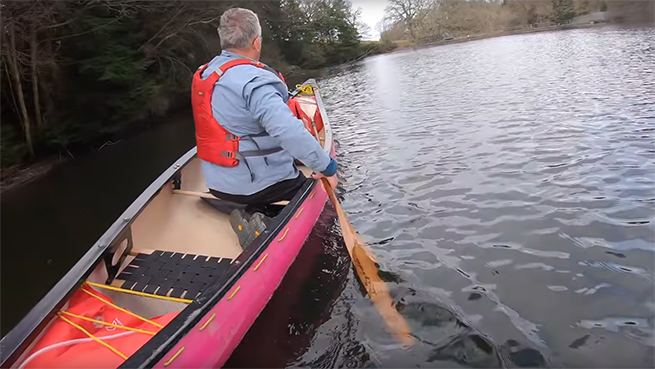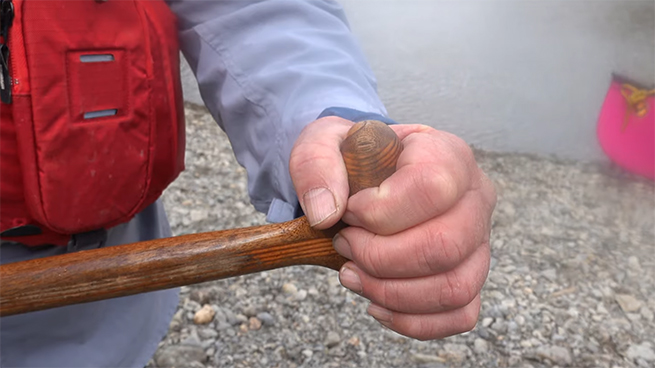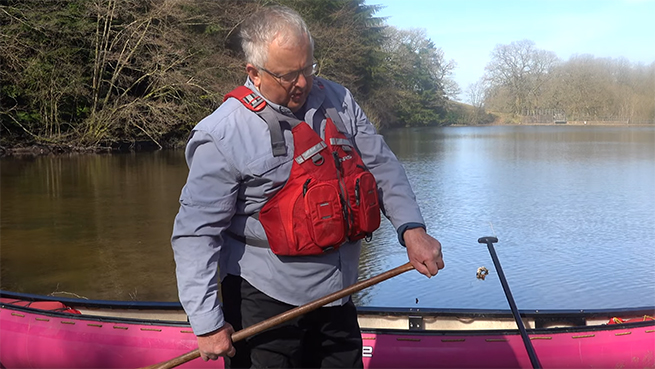
The Need For Steering
Even in easy conditions, whether we are paddling a canoe solo, or paddling tandem, we are going to have to do some form of steering. There’s a whole variety of strokes that you can use. What we are also interested in is travelling forwards. So, for efficiency, we are interested in power strokes that also incorporate some steering.
Two Families Of Power Strokes With Steering
There are two major families of strokes that we use to steer the canoe. One family, which very powerful, contain the stern rudder and stern pry. We use these a lot in white water or coming down a lake with a strong tailwind.
One of the characteristics of these strokes is that I pull with the power face, but then to steer I switch faces and steer with the back face. See the video below for clear examples.
So it’s a case of pull, change blade face, steer with the other side to the power face. I can do that either on the gunwale or off the gunwale. When it’s off the gunwale, I tend to call it a stern rudder. On the gunwale, a stern pry.

Another useful marker in this family of strokes – the stern rudder and the stern pry – is that during the steering phase the thumb on the grip end of the paddle is at the top or up.
Introducing The J-Stroke
The second family of strokes are all based around the J-stroke. These include the C-stroke, the Indian stroke, the knifed-J, which sometimes goes by the name of Canadian stroke or guide stroke. Fundamentally, they’re all variants of the basic J-stroke but subtly different.
Compare this to the first family of strokes – the stern rudder and the stern pry: I pull through, again using the same power face but this time I twist and I turn it outwards to steer. So I’ve used the same blade face for power and for steering. Again, see the video below for clear examples being demonstrated.
So in the J-stroke, because the paddle is rotated around, the hand on the grip is now on the outside, and the thumb is pointing down.

So one of the real important things with this is this movement of the hand on the top of the paddle. In the power phase of the stroke, my hand is pretty well on the top. But as it comes down into the J-stroke, my hand slides around slightly so it’s no longer gripping the top. But that takes the stress out of the wrist and allows me to pull back very easily. Watch the video below to see this in action….
Get The J-stroke Video Transcript:
Click here to download a full transcript of the J-stroke video.
Can I Do A J-Stroke With A T-Grip On My Paddle?
In a word, yes! I could do the same as described above with a T-grip. So my hand is on the top for the power element as before, but as I come into the steer my hand moves round subtly onto that face. This means I’ve actually loosened the grip with the fingers, removing the stress. The problem with this stress on the hand and wrist is if you don’t get the movement right, then as you come into the steer, some people end up with a really awkward hand position. It’s not very strong, it’s not very useful. So you really have to learn to allow the grip hand to slide round slightly.
Can I Do A J-Stroke Sitting On The Seat, Or Do I Have To Kneel?
Sometimes I will sit, but the majority of time when I’m solo, or it’s white water, or it’s windy, I’m going to be kneeling. We’ve got a number of options here. As you can see in the video because I’m in the boat solo, and it’s a small, tandem boat, I actually can paddle it back to front. This is the traditional way, with the load up in front of me. I’m using the bow seat in reverse. I can sit on the seat with my legs up or I can kneel with my backside on the edge of the seat. If I want stability, I keep my knees nice and wide. If I want to make my life easier, so I can reach over the side to get a more vertical power stroke, or for steering, then I can move my knees across towards that side. The boat then heels over and becomes more manoeuverable. And it’s much easier to get a good quality power stroke with my hands across the side of the boat. It’s much easier to do my J-stroke. Have a look at the video and you can see me demonstrating this.
Latest posts by Ray Goodwin (see all)
- Mastering The J-Stroke - April 15, 2020
- Downcreek Big Dipper: The Evolution Of An Outstanding Paddle - February 21, 2017
- Outfitting My Canoe: Ray Goodwin - September 19, 2013

Nigel Gregory
Hi Ray,
Many thanks for the video and also your written material, will look forward to seeing more of your blogs, Thankyou Paul for putting it on your blog.
Hope you and your families are well,
Nige.